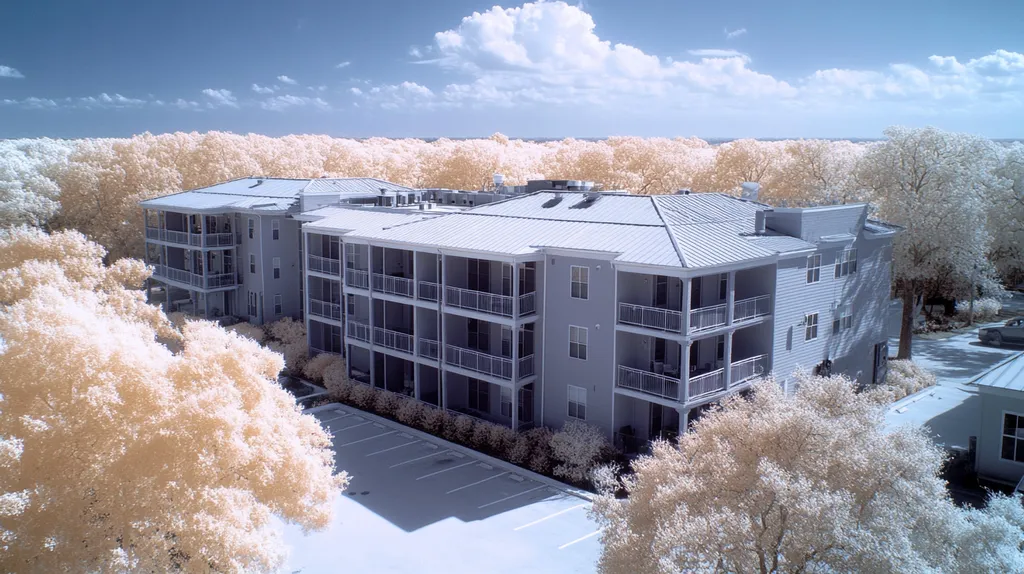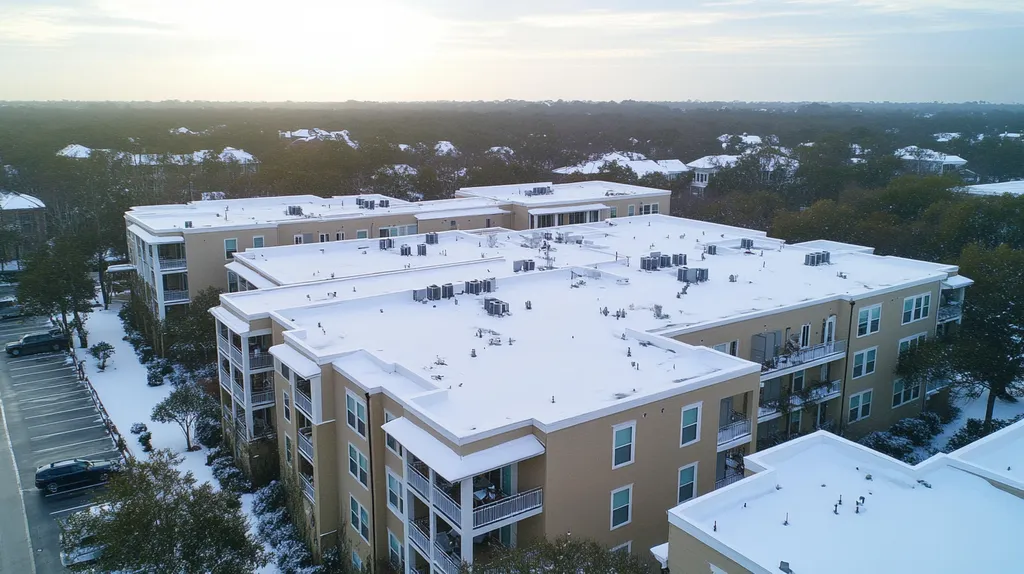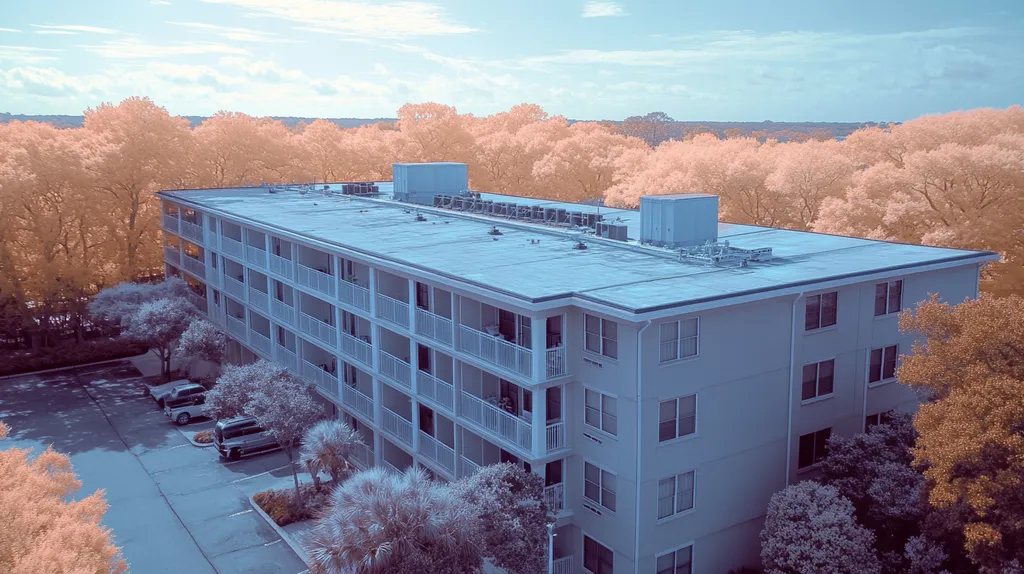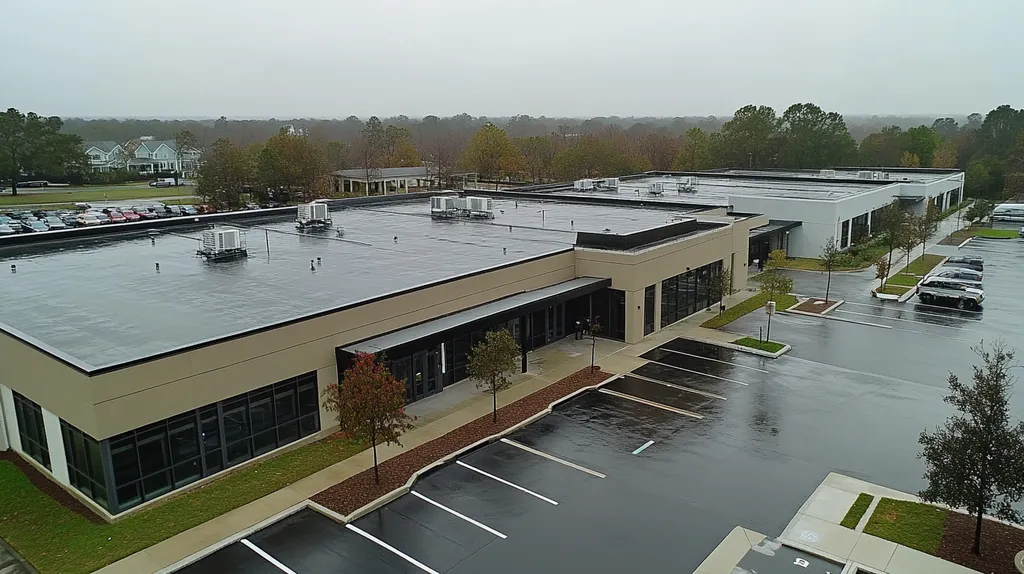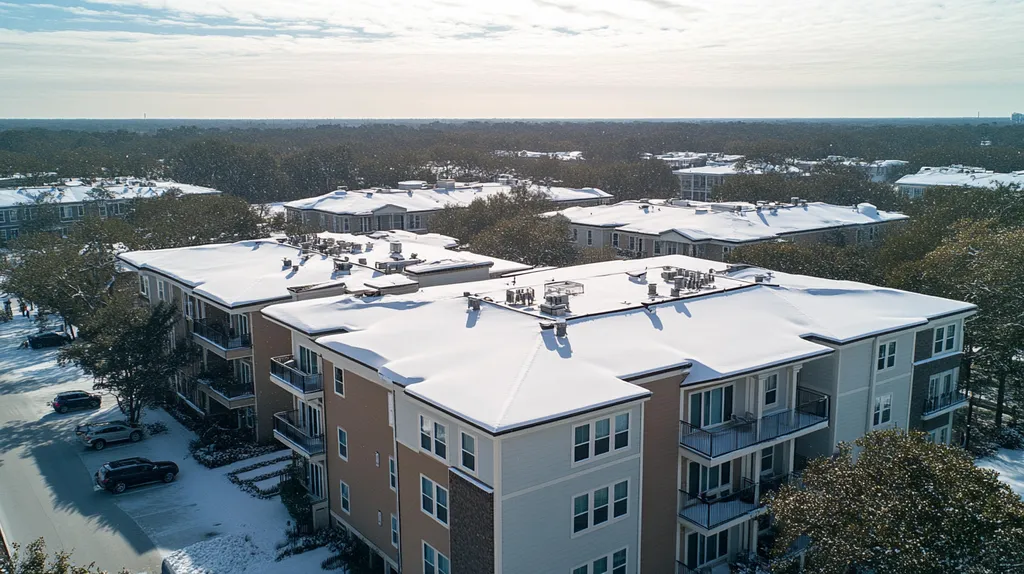Every year, commercial roof fires cause over $1 billion in property damage and business interruption losses across the United States. Even more concerning, 70% of businesses experiencing major roof fires never fully recover.
For facility managers and property owners, understanding modern fire safety measures isn’t just about code compliance—it’s about protecting critical assets, ensuring business continuity, and safeguarding human lives.
This comprehensive guide examines essential fire safety systems, materials, and protocols that defend commercial roofs against catastrophic fire events. From basic terminology to advanced protection strategies, we’ll explore the critical elements that keep your facility secure.
SECTION 1: THE BASICS EXPLAINED
Commercial roof fires represent one of the most devastating threats to business operations, often resulting in complete building losses and business interruption. Beyond the immediate fire damage, smoke and water from firefighting efforts can destroy inventory, equipment, and interior spaces. Understanding and implementing proper fire safety measures isn’t just about code compliance—it’s about protecting your investment, employees, and business continuity.
What It Is (In Plain Language)
Rooftop fire safety is a comprehensive system of physical barriers, detection equipment, and maintenance protocols designed to prevent, contain, and suppress fires. These measures work together to protect the building’s most vulnerable point—its roof.
The foundation starts with fire-rated roofing materials, which are specifically engineered to resist flame spread. These materials are tested and rated based on their ability to withstand fire exposure without igniting or allowing fire penetration.
Fire barriers and stops are installed at regular intervals across the roof surface to compartmentalize potential fires. These divisions prevent a small fire from rapidly spreading across the entire roof area.
Modern fire safety systems also include integrated detection and suppression equipment, from heat sensors to sprinkler systems. These active protection measures provide crucial early warning and automatic response capabilities.
Why It Matters (To Your Building)
A roof fire can spread rapidly through a building, doubling in size every minute without proper containment measures. This explosive growth potential makes rooftop fire protection your first line of defense against catastrophic loss.
Beyond protecting physical assets, proper fire safety measures directly impact insurance premiums and coverage availability. Many insurers offer significant rate reductions for buildings with comprehensive fire protection systems.
Rooftop fire safety also affects your building’s compliance with local codes and regulations. Violations can result in hefty fines, forced closures, or legal liability if a fire occurs.
Employee safety depends heavily on effective fire protection. A well-protected roof gives occupants crucial extra minutes to evacuate safely during a fire emergency.
How It Works
Effective rooftop fire safety relies on multiple layers of protection working in concert. The first layer consists of keeping roofs clear of potential fire hazards and maintaining clear access paths for firefighters.
Regular inspections ensure fire safety systems remain functional and roof surfaces stay free of combustible materials. This includes removing debris and maintaining proper drainage to prevent water accumulation that could hamper firefighting efforts.
Every business must maintain an Emergency Action Plan (EAP) that details evacuation procedures and emergency responses. This plan should be prominently displayed and regularly reviewed with all employees.
Proper maintenance includes keeping rooftop areas clear of obstructions like wires, ropes, and cables that could impede firefighter access during emergencies. (source: Telgian)
SECTION 2: PRACTICAL APPLICATIONS
Fire safety measures on commercial roofs represent a critical line of defense against catastrophic loss. Recent industry data shows that rooftop-originated fires cause over $1 billion in annual damages across commercial properties. Understanding and implementing proper fire safety measures requires careful consideration of material selection, system integration, and emergency response protocols. This section examines how these elements work together to create comprehensive protection for commercial facilities.
Common Uses & Examples
Fire-resistant roofing materials form the foundation of effective protection. Class A rated materials like modified bitumen and properly treated metal panels provide the highest level of fire resistance, critical for facilities with high-value assets or sensitive operations.
Parapet walls and fire barriers segment large roof areas into manageable sections. These physical divisions prevent rapid fire spread and create natural firebreaks that give emergency responders crucial time to contain incidents.
Rooftop equipment zones require specialized attention. HVAC units, exhaust systems, and other mechanical equipment must maintain proper clearances from combustible materials and undergo regular inspection for potential ignition sources.
Solar panel installations demand particular consideration. Proper spacing between arrays ensures adequate access for firefighters while reducing the risk of electrical fires spreading across the roof surface.
When You Need It Most
Open spaces and unobstructed emergency evacuation routes represent essential fire safety measures. Clear pathways allow firefighters quick access while providing safe exit routes for building occupants.
Illuminated exit signage and emergency lighting systems must remain continuously visible. These crucial components guide occupants to safety during power failures or when smoke obscures normal visibility.
Integrated fire alarm systems provide early detection and immediate alert capabilities. These interconnected components work together to enhance response times and maximize occupant safety during emergencies. (source: AIE Fire Protection)
Facilities undergoing renovations or equipment upgrades face heightened fire risks. Extra precautions during construction, including fire watches and temporary barriers, protect vulnerable areas until permanent systems are restored.
Interactions With Other Systems
Building ventilation systems play a crucial role in fire safety. Properly maintained exhaust fans prevent heat buildup near rooftop equipment while smoke evacuation systems clear escape routes during emergencies.
Drainage systems must remain clear to prevent water pooling that could hamper firefighting efforts. Regular inspection and maintenance of drains, scuppers, and downspouts ensures water can flow freely during emergency response.
Lightning protection systems require integration with fire safety measures. Proper grounding and surge protection prevent electrical fires while maintaining the integrity of fire detection and suppression systems.
Access control systems must automatically release during fire events. This coordination ensures emergency responders can quickly reach affected areas while allowing occupants to evacuate without delay.
SECTION 3: KEY TERMINOLOGY DECODED
Fire safety terminology in commercial roofing can mean the difference between effective protection and catastrophic failure. Each year, misunderstandings of critical fire safety terms lead to costly mistakes in material selection and system design. Clear comprehension of these terms enables property owners to make informed decisions that protect their investments and occupants.
Essential Terms Explained
Fire-resistance ratings classify how long roofing materials can withstand direct flame exposure. Class A materials offer the highest protection, resisting severe fire exposure for up to 4 hours, while Class C materials provide only basic protection.
Flame spread indexes measure how quickly fire travels across roofing surfaces. A rating of 0-25 indicates superior performance, while ratings above 75 suggest materials that could accelerate fire spread.
Fire barriers segment roofs into contained zones, preventing rapid fire progression. These crucial components must maintain their integrity to effectively compartmentalize flames and protect evacuation routes.
Fire suppression systems include both active and passive components. Active systems like sprinklers respond automatically to fire events, while passive barriers like firewalls provide constant protection without mechanical activation.
Industry Jargon Translated
Surface burning characteristics encompass both flame spread and smoke development. These properties determine how roofing materials behave during fire exposure and directly impact occupant safety.
Dry-chemical fire extinguishers must be placed every 100 feet across commercial roofs, with a minimum 2A rating for every 3,000 square feet of protected area. Regular inspection and proper placement ensure these critical tools remain ready for emergency use. (source: OSHA)
Fire watches maintain constant vigilance during and after hot work operations. This human monitoring supplements mechanical detection systems when normal protections are compromised.
Smoke development ratings indicate visibility conditions during fires. Lower ratings mean clearer evacuation paths and safer conditions for first responders.
Measurement & Units Simplified
Time-temperature curves show how materials respond to increasing heat. These measurements help predict material performance during actual fire events.
Heat release rates, measured in kilowatts (kW), indicate fire intensity. Understanding these values helps determine appropriate safety margins for roofing systems.
Thermal resistance values (R-values) measure insulation effectiveness. Higher R-values typically indicate better fire protection, as these materials slow heat transfer through roof assemblies.
Fire endurance testing measures performance in minutes or hours. These standardized assessments provide comparable data for evaluating different roofing solutions under controlled conditions.
SECTION 4: DECISION FACTORS
When evaluating fire safety measures for commercial roofs, property owners face critical decisions that directly impact building protection and occupant safety. Recent data shows that inadequate fire safety measures contribute to over $3 billion in annual commercial property losses. Understanding key decision factors helps facility managers balance immediate budget constraints against long-term safety requirements while meeting regulatory compliance standards.
Cost Considerations
Initial investment in fire-rated roofing materials typically runs 15-30% higher than standard options. However, these costs are often offset by reduced insurance premiums, extended warranty coverage, and decreased maintenance requirements over the system’s lifespan.
Installation costs vary significantly based on chosen fire safety features. Simple fire barriers may add minimal expense, while comprehensive detection and suppression systems require substantial investment in both materials and specialized labor.
Regular maintenance costs must factor into the total investment calculation. High-quality fire safety systems often require less frequent repairs but demand consistent professional inspection to maintain their protective capabilities.
Life-cycle cost analysis reveals that premium fire safety measures typically deliver positive returns within 5-7 years through reduced insurance costs and avoided damage expenses.
Performance Trade-offs
Fire resistance ratings directly impact material selection and system design. Class A rated assemblies offer superior protection but may limit options for thermal efficiency or solar reflectivity.
Building access and emergency evacuation requirements influence rooftop layout and safety system placement. Clear pathways and proper lighting must be maintained while maximizing usable roof area.
Integration with existing building systems affects overall performance. Fire safety measures must coordinate with ventilation, drainage, and electrical systems without compromising their primary protective function.
Weather resistance capabilities often compete with fire safety features. Materials must balance flame resistance against their ability to withstand UV exposure, temperature cycles, and moisture penetration.
Lifespan & Durability Factors
Fire-resistant roofing systems typically offer service lives of 20-30 years when properly maintained. This extended durability helps justify higher initial costs while ensuring consistent protection throughout the roof’s lifecycle.
Environmental exposure affects long-term performance of fire safety features. UV degradation, thermal cycling, and chemical exposure can reduce effectiveness of flame-retardant materials over time.
Exit signs and emergency lighting systems require regular testing and maintenance to ensure reliable operation during emergencies. These critical components must remain functional even during power outages to protect building occupants. (source: AIE Fire)
Warranty terms and maintenance requirements vary significantly between systems. Premium fire safety measures often include longer coverage periods but may specify more stringent maintenance protocols to maintain protection levels.
SECTION 5: COMMON CHALLENGES
Commercial roof fire safety faces increasing complexity as buildings incorporate more rooftop equipment and sustainable technologies. Industry data shows that 40% of commercial roof fires start from preventable maintenance issues or overlooked warning signs. With modern roofs housing everything from HVAC systems to solar arrays, the potential ignition sources have multiplied dramatically. Understanding these challenges is crucial for maintaining effective fire protection.
Frequent Problems & Solutions
Improper maintenance around rooftop equipment creates dangerous fire conditions. Accumulated grease from kitchen exhaust systems and debris around HVAC units provide ready fuel sources that can quickly ignite.
Penetrations through fire-rated assemblies often lack proper sealing after repairs or modifications. These gaps compromise the entire roof’s fire resistance rating and create pathways for flame spread.
Aging or improperly installed lightning protection systems can actually increase fire risks. Regular testing and maintenance of these systems is essential, as deteriorated components can become ignition sources during storms.
Solar panel installations frequently block access to fire suppression equipment and evacuation routes. Proper spacing and pathway planning must be incorporated during system design to maintain safety compliance.
Warning Signs To Watch For
Visible damage to fire barriers or penetration seals requires immediate attention. Even small breaches can allow rapid fire spread between roof sections that should remain compartmentalized.
Blocked or deteriorated drainage systems create standing water that can interfere with electrical systems and weaken fire-resistant materials. Regular drainage inspection prevents these hazardous conditions from developing.
Emergency lighting systems with failing backup batteries pose serious evacuation risks. These critical safety components require regular testing to ensure reliable operation during power outages.
Proper illumination and unobstructed pathways to fire safety equipment must be maintained at all times. Clear access routes allow firefighters to quickly reach affected areas while enabling safe building evacuation. (source: AIE Fire Safety Blog)
Preventative Approaches
Implementing comprehensive maintenance schedules addresses potential issues before they become hazards. These programs should include regular cleaning, inspection of fire barriers, and testing of safety systems.
Staff training on fire safety protocols and equipment operation proves essential for early problem identification. Well-trained personnel can spot warning signs and initiate corrective actions before conditions become dangerous.
Documentation of all fire safety maintenance and testing provides crucial compliance records. These logs help track system performance over time while demonstrating due diligence in maintaining protection measures.
Integration of fire safety considerations into all roof modification projects prevents inadvertent compromise of existing protection. Even minor changes must be evaluated for their impact on overall system effectiveness.
SECTION 6: NEXT STEPS & RESOURCES
Commercial roof fires cause devastating losses, with damages often reaching millions per incident. Taking proactive steps through proper planning and provider selection can mean the difference between minor incidents and catastrophic failures. Understanding current standards, asking the right questions, and accessing quality resources helps facility managers implement effective fire safety measures that protect both assets and occupants.
Questions To Ask Providers
Start by verifying the provider’s specific experience with fire-rated roofing systems and materials. Request detailed documentation of their fire safety training programs and certifications for both installation crews and supervisors.
Ask about their familiarity with local fire codes and how they ensure compliance during installation and maintenance. Providers should demonstrate clear understanding of both regional requirements and industry best practices.
Request their standard procedures for fire watch during hot work operations, including torch-applied roofing. Qualified providers will have detailed protocols for monitoring work areas and maintaining proper fire suppression equipment.
Discuss their quality control processes for fire safety installations, including how they verify proper placement of fire barriers and penetration seals. Documentation of these inspections provides crucial verification of proper installation.
Industry Standards & Guidelines
Dry-chemical fire extinguishers must be stationed every 100 feet across commercial roofs, with specific rating requirements based on roof size and hazard classification. All roofing personnel require initial and annual training on proper extinguisher operation and emergency protocols. (source: OSHA)
UL fire resistance classifications provide standardized metrics for comparing roofing materials and assemblies. These ratings help facility managers select appropriate materials for their specific fire safety needs.
FM Global standards outline detailed requirements for roof assembly testing and certification. Their guidelines often exceed minimum code requirements, offering enhanced protection for high-value facilities.
International Building Code (IBC) requirements establish baseline fire safety measures for commercial roofs. These standards address everything from material ratings to emergency access requirements.
Further Learning Simplified
Professional organizations like NRCA and NFPA offer targeted training programs on commercial roof fire safety. These courses provide practical knowledge directly applicable to facility management.
Technical bulletins from major manufacturers detail specific installation requirements for maintaining fire ratings. Understanding these specifications helps ensure proper system performance.
Industry publications regularly feature updates on evolving fire safety technologies and best practices. Staying current with these developments helps facility managers make informed decisions about system upgrades.
Local fire marshals often provide guidance on specific regional requirements and concerns. Regular consultation with these authorities helps maintain compliance while addressing unique facility challenges.
The Bottom Line
With commercial roof fires causing over $1 billion in annual losses and forcing 70% of affected businesses to close permanently, implementing comprehensive fire safety measures isn’t optional—it’s essential for survival.
Modern roofing systems face unprecedented challenges from increased mechanical equipment, solar installations, and complex building systems that create multiple potential ignition sources.
Success requires a multi-layered approach combining proper material selection, regular maintenance, staff training, and integration with building-wide safety systems.
The cost of adequate fire protection pales in comparison to the devastating financial impact of a major roof fire, making investment in proper safety measures one of the most critical decisions a facility manager can make.
FREQUENTLY ASKED QUESTIONS
Q. What are the basics of fire safety measures for commercial roofs?
A. Fire safety measures include barriers, detection equipment, and maintenance protocols. These systems protect roofs from fire damage, ensuring business continuity and employee safety. Understanding these basics is vital for effective fire protection.
Q. How are fire safety measures applied to a commercial roof?
A. Effective applications include using fire-resistant materials, installing fire barriers, and maintaining clear access for emergency responders. Regular inspections and maintenance of equipment further enhance safety and minimize fire risks on the commercial roof.
Q. What key terms should I know about fire safety for an industrial roof?
A. Understanding fire-resistance ratings, flame spread indexes, and fire suppression systems is crucial. Knowing these terms helps make informed decisions that can significantly affect safety and compliance for an industrial roof.
Q. What decision factors should I consider for commercial roof safety?
A. Consider cost-effectiveness of materials, installation requirements, and performance ratings. Balancing initial investments with long-term safety benefits will help ensure effective protection for your commercial roof.
Q. What common challenges arise in commercial roof fire safety?
A. Challenges include inadequate maintenance around rooftop equipment and gaps in fire-rated assemblies. Identifying and addressing these issues is vital for preventing fire risks and ensuring safety on commercial roofs.
Q. What next steps should I take for fire safety on my commercial roof?
A. Start by assessing current fire safety measures and consulting with qualified providers. Inquire about industry standards and seek further training to stay informed about best practices for your commercial roof.
Q. How often should I inspect fire safety measures on commercial roofs?
A. Regular inspections should occur at least twice a year or after severe weather events. Ensuring all fire safety measures are functional is crucial for maintaining compliance and protecting your commercial roof.

